#comet hyakutake
Text

The Colours of Comet Hyakutake - March 29th, 1996.
"The colours of Comet Hyakutake are caused by the action of sunlight on the dust, and gas produced by the warming nucleus. The microscopic dust particles reflect sunlight, while the Sun's ultraviolet radiation excites and ionises the gas molecules, causing them to glow or fluoresce in a range of visible colours. This enhanced colour picture reveals subtle colour changes across the cometary coma and a faint multicoloured tail. It was made on the night of March 18th-19th, 1996 by combining separate green, red, and blue photographs, each about a 15 minute exposure. Some of the colour features in the tail may well represent real changes in its structure from one exposure to the next. The coloured star trails, created as the Anglo-Australian Observatory's UK Schmidt Telescope tracked the rapidly moving comet, indicate the order of the separate exposures. The cometary hues revealed here can not be seen directly due to the human eye's lack of colour vision at the low light levels involved."
125 notes
·
View notes
Text
#BlogchatterBlogHop – Would you rather visit the moon or Mars?
This post is a part of Blogchatter Blog Hop.
The moon has always called out to me. I recall camping on my terrace with friends as a child and gazing upon the moon from inside my makeshift tent. I recall writing an essay on the cosmos and drawing upon my knowledge of Colin A. Ronan’s ‘The Skywatcher’s handbook’ and including a few lines about the moon. I remember Moonface from Enid Blyton’s The Magic Faraway Tree. And how can I forget the…

View On WordPress
0 notes
Photo
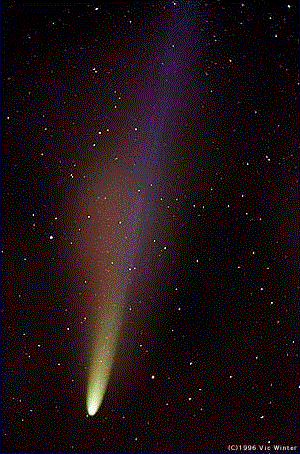
The Tails of Comet Hyakutake
Credits: Discover the cosmos!, Vic Winter, ICSTARS
136 notes
·
View notes
Text
La sonda Voyager 1, seppur partita qualche giorno dopo Voyager 2, è ad oggi l'oggetto costruito dalla nostra specie più distante in assoluto: quasi 24 miliardi di km dalla Terra. Ci ha messo più di 45 anni per arrivare così lontano. E nonostante questa distanza sembri enorme, si tratta solo dello 0,25% di un anno luce. È ancora nel giardino di casa.
Infatti, non solo è impensabile immaginare che raggiunga le stelle più vicine al Sole, ma non ha nemmeno ancora raggiunto la nube di Oort, il posto da cui hanno origine le comete a lungo periodo (come Hale-Bopp e la Hyakutake). Sicuramente ci arriverà da spenta, visto che si stima ci impiegherà altri 300 anni. E il piccolo reattore nucleare di bordo non durerà probabilmente oltre il 2030.
E pensare che, per risparmiare energia, il 14 febbraio 1990, a "soli" 6 miliardi di km da casa, scattò un'ultima fotografia alla Terra: la famosa foto chiamata "Pale Blue Dot". Per poi, 34 minuti dopo, diventare cieca per sempre.

29 notes
·
View notes
Text
How Big is Comet Hyakutake
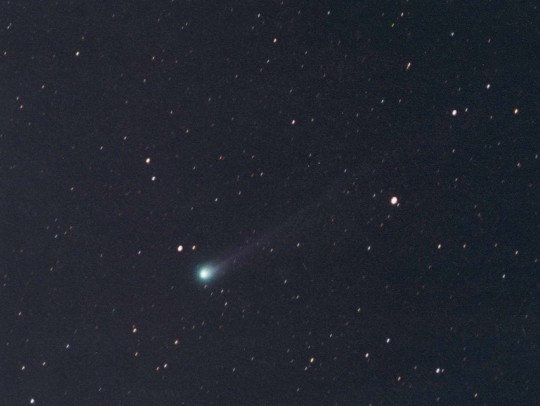
Comets are like mysterious visitors in the sky that have always interested people. They show up at night, making us think about the universe and how big it is. Comet Hyakutake is remembered as an important part of space history. In 1996, Comet Hyakutake amazed people who love looking at the stars all around the world. But it wasn't just pretty to look at—it also helped scientists learn a lot about comets. In this article, we delve into the fascinating journey of Comet Hyakutake, exploring its discovery, characteristics, and the impact it had on both scientific understanding and public fascination. Read more
#science#astronomy#space#universe#education#ar 3595#physics#sol#sunspot#sunspot number#comet#information
2 notes
·
View notes
Note
top 5 cosmic objects
hehe
1. MOOOOOOOOOON :33 ☺️🌙
2. comets.. i love comets i love seeing comets and then sixty years later it comes back again because space works like that. halley’s comets and comet hyakutake specifically
3. supernovas hehe ig they technically aren’t cosmic bodies but. i would love to reach the end of my life and explode into bursts of light
4. andromeda galaxy hehe would love to go there
5. i love a good old star i would love to see them sometime 😔
#asks#kai tag#honorary mention earth. poor girl#i love space 🥹🥹🥹🥹🥹🥹🥹🥹🥹🫶🏻🫶🏻🥹🫶🏻😭😭🥹🥹🥹🥹😭😭😭🫶🏻💔💔💔🥹🫶🏻🥹🥹🫶🏻🥹🥹🥹🫶🏻🥹🥹🥹💔💔💔💔#sad
4 notes
·
View notes
Text

Comet Neowise streaks through the night sky above the forests of Girona, Spain, leaving behind a glowing trail of gas and dust. Humans have long had a fascination with comets and asteroids—both beautiful and menacing as they hurtle past Earth. Photograph By Juan Carlos Casado, Science Photo Library

Comet Hyakutake in the night sky. Among the brightest comets observed in the 20th century, Hyakutake passed 15 million kilometers from Earth on March 25, 1996. It is a long-period comet: it last appeared at least 10,000 years ago, and its next visit will be in about 20,000 years. Photograph By Jerry Lodriguss/Science Photo Library

Meteor Crater, also known as Barringer Crater, was formed roughly 50,000 years ago when an approximately 150-foot meteorite struck the Arizona desert at an estimated 2,600 miles per hour. The collision left a crater approximately 4,000 feet wide. Photograph By Francois Goheir, Gamma-Rapho/Getty Images
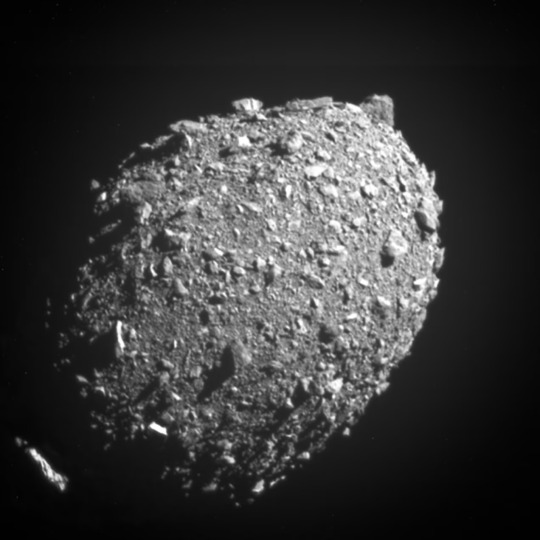
In 2022, NASA slammed a spacecraft into the asteroid Dimorphos, a moonlet of the larger asteroid Didymos, to test whether they could knock it off its orbit. The spacecraft captured this image of Dimorphos 11 seconds before impact—which was a smashing success. Photograph By NASA/John Hopkins APL
2 notes
·
View notes
Text
Events 4.4 (after 1950)
1958 – The CND peace symbol is displayed in public for the first time in London.
1960 – France agrees to grant independence to the Mali Federation, a union of Senegal and French Sudan.
1963 – Bye Bye Birdie, a musical romantic comedy film directed by George Sidney, was released.
1964 – The Beatles occupy the top five positions on the Billboard Hot 100 pop chart.
1967 – Martin Luther King Jr. delivers his "Beyond Vietnam: A Time to Break Silence" speech in New York City's Riverside Church.
1968 – Martin Luther King Jr. is assassinated by James Earl Ray at a motel in Memphis, Tennessee.
1968 – Apollo program: NASA launches Apollo 6.
1969 – Dr. Denton Cooley implants the first temporary artificial heart.
1973 – The Twin Towers of the World Trade Center in New York City are officially dedicated.
1973 – A Lockheed C-141 Starlifter, dubbed the Hanoi Taxi, makes the last flight of Operation Homecoming.
1975 – Microsoft is founded as a partnership between Bill Gates and Paul Allen in Albuquerque, New Mexico.
1975 – Vietnam War: A United States Air Force Lockheed C-5A Galaxy transporting orphans, crashes near Saigon, South Vietnam shortly after takeoff, killing 172 people.
1977 – Southern Airways Flight 242 crashes in New Hope, Paulding County, Georgia, killing 72.
1979 – Prime Minister Zulfikar Ali Bhutto of Pakistan is executed.
1981 – Iran–Iraq War: The Islamic Republic of Iran Air Force mounts an attack on H-3 Airbase and destroys about 50 Iraqi aircraft.
1983 – Space Shuttle program: Space Shuttle Challenger makes its maiden voyage into space on STS-6.
1984 – President Ronald Reagan calls for an international ban on chemical weapons.
1987 – Garuda Indonesia Flight 032 crashes at Medan Airport, killing 23.
1988 – Governor Evan Mecham of Arizona is convicted in his impeachment trial and removed from office.
1990 – The current flag of Hong Kong is adopted for post-colonial Hong Kong during the Third Session of the Seventh National People's Congress.
1991 – Senator John Heinz of Pennsylvania and six others are killed when a helicopter collides with their airplane over an elementary school in Merion, Pennsylvania.
1991 – Forty-one people are taken hostage inside a Good Guys! Electronics store in Sacramento, California. Three of the hostage takers and three hostages are killed.
1994 – Three people are killed when KLM Cityhopper Flight 433 crashes at Amsterdam Airport Schiphol.
1996 – Comet Hyakutake is imaged by the USA Asteroid Orbiter Near Earth Asteroid Rendezvous.
1997 – Space Shuttle program: Space Shuttle Colombia is launched on STS-83. However, the mission is later cut short due to a fuel cell problem.
2002 – The MPLA government of Angola and UNITA rebels sign a peace treaty ending the Angolan Civil War.
2009 – France announces its return to full participation of its military forces within NATO.
2010 – A magnitude 7.2 earthquake hits south of the Mexico-USA border, killing two and damaging buildings across the two countries.
2011 – Georgian Airways Flight 834 crashes at N'djili Airport in Kinshasa, killing 32.
2013 – More than 70 people are killed in a building collapse in Thane, India.
2017 – Syria conducts an air strike on Khan Shaykhun using chemical weapons, killing 89 civilians.
2020 – China holds a national day of mourning for martyrs who died in the fight against the novel coronavirus disease outbreak.
2023 – Finland becomes a member of NATO after Turkey accepts its membership request.
0 notes
Link
New Comet P1 Nishimura graces the August dawn sky…but how bright will it get? Hello. In a predictable clockwork Universe, a new comet is always the one wildcard that can over- or under-perform expectations. The most dramatic ones often crop up with scant warning: witness Comet IRAS-Araki-Alcock in 1983, and Comet B2 Hyakutake in 1996. Now, we have a new comet that could reach naked eye visibility over the next few weeks: C/2023 P1 Nishimura. The comet was discovered by Hideo Nishimura while shooting wide-field images from Kakegawa, Japan on the night of August 11th. At the time, the comet displayed respectable a 5’ coma. Score one for the human observers, versus robotic all-sky surveys… Getting brighter… Comet C/2023 P1 Nishimura from August 15th, just before confirmation. Image credit and copyright: Dan Bartlett. Currently at +9th magnitude (with a bullet) in the constellation Gemini, the comet is now well-placed in the predawn sky. With binoculars, I could just make out the smudge of the comet this morning near Delta Geminorum. I was observing from Jimena de la Frontera in southern Spain. The comet was initially listed as simply HN00003 on the IAU’s Minor Planet Center PCCP site, before receiving a formal name. P1 Nishimura is expected to brighten to +3 or +2 magnitude in early September, though it will also be near the Sun at that time. The comet passes 0.29 Astronomical Units (AU) or 43 million kilometers (26.7 million miles) from the Earth on September 13th, and reaches perihelion 0.22 AU (33 million kilometers or 20.5 million miles) from the Sun interior to the orbit of Mercury on September 18th. An Intriguing Orbit At its closest approach to Earth in mid-September, the comet will cross four degrees of sky per day. The orbital path of Comet Nishimura. Credit: NASA/JPL. Unfortunately, the comet also ‘takes the plunge’ sunward in early September, and passes only 12 degrees from the Sun in mid-September before heading southward. It’ll also juuuust miss the joint NASA/ESA SOHO’s LASCO C3 field of view. Too bad it didn’t come by in December, as it would’ve passed just 0.06 AU (9 million kilometers or 5.6 million miles) from the Earth, and would’ve been a truly spectacular comet. Keep in mind, as of writing this, the NASA/JPL ephemeris for the orbital solution for the comet is only from 63 observations over a four day span; expect the final orbit for the comet to get tweaked a bit as its path and position through space is better known (it’s that new!) P1 Nishimura crept up on us from south and sunward, which is most likely how it evaded detection earlier this summer. On a steep orbit inclined 129° relative to the ecliptic plane, Comet P1 Nishimura is on a retrograde path. This means its moving opposite to the planets in the inner solar system. The comet also looks to has an orbital eccentricity of slightly greater than 1.0, meaning it’s most likely a dynamically new visitor to the inner solar system from the distant Oort Cloud, due to get ejected towards galactic space in the direction of the southern constellation Pyxis after perihelion. How Bright? As a first time newcomer approaching the Sun, P1 Nishimura could prove to be an active one, another plus. Late August sees the comet 20° above the eastern horizon one hour before sunrise as seen from latitude 35° north. Also, watch for a brilliant crescent Venus entering the dawn view. Venus is fresh off of inferior conjunction on August 13th. We’re seeing the comet approaching the Sun on a nearly perpendicular path from our Earthbound perspective. This is an ideal geometry to spy a dust tail, should the comet sprout one towards perihelion. The apparent path of Comet P1 Nishimura through the dawn sky from August 17th through September 7th as seen from latitude 35 degrees north. Note that the background celestial view is for the end of the path. Credit: Starry Night. The comet then begins its dramatic plunge towards the eastern horizon in early September, becoming increasingly difficult to observe. The following evening apparition will be a brief and bashful one for northern observers. The comet only climbs 5° above the western horizon, 30 minutes after sunset around September 16th as seen from 35° north. The Comet Month by Month Here’s a look at celestial dates with destiny for Comet P1 Nishimura over the next few months. Unless otherwise noted, ‘near’ denotes a pass or conjunction of less than one degree, or the diameter of two full Moons. August 19- Passes 16’ from the ‘Clown Face’ Nebula NGC 2392. 22- Crosses the ecliptic plane northward. 26- Crosses into the constellation Cancer. 31- Passes 4 degrees from the open cluster Messier 44. The celestial path of Comet P1 Nishimura, through October 1st. Credit: Starry Night. September 5-Crosses into the constellation Leo. 7-Passes near the +3rd magnitude star Epsilon Leonis. 9-Passes near the +3.4 magnitude star Zeta Leonis. 13-Earth closest approach at 0.29 AU distant. 15-Passes in front of (transits) the +2nd magnitude star Denebola (Beta Leonis). 16-Crosses into the constellation Virgo, and reaches a minimum elongation of 12 degrees from the Sun. 18-May top out at +2nd magnitude, as the comet reaches perihelion at 0.22 AU from the Sun. 21-Crosses the celestial equator southward. 24-Crosses the ecliptic southward. October 1-Drops below +10th magnitude. Farewell For Comet Nishimura From there, the comet begins its long journey out of the solar system. Southern observers may still see Comet P1 Nishimura as it departs, never to be seen by human eyes again. The projected light curve for Comet P1 Nishimura. Adapted from Seiichi Yoshida’s Weekly Information About Bright Comets. Your best bet at spotting Comet P1 Nishimura is to sweep the suspect area of sky with binoculars, or a low power telescopic field of view. Watch for a fuzzy blob that refuses to snap into focus. COBS (The Comet Observer’s Database) is an excellent source to see what the comet is currently doing, and Heavens Above will generate wide and narrow field of view finder charts for the comet. Gideon van Buitenen’s comet page will also produce inverted finder charts (black stars on a white background) for a given comet. Though +6th magnitude is usually quoted as the cut off for naked eye visibility, comets are diffuse objects. In past experience, comets like F3 NEOWISE in 2020 only became conspicuous objects able to be captured along with foreground objects when they hit brighter than +3rd magnitude or so. The hunt is now on, to nab Comet C/2023 P1 Nishimura in the dawn sky. The post Comet P1 Nishimura Could Be Bright Over the Next Few Weeks appeared first on Universe Today.
0 notes
Text
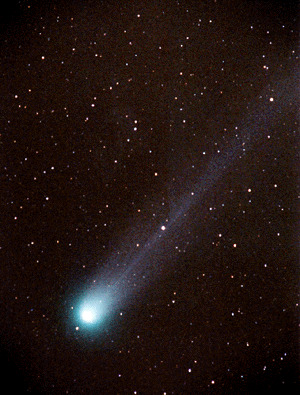
What are Comet Tails Made Of? - March 26th, 1996.
"The tail of Comet Hyakutake, visible in this colour image, is composed of dust and gas driven off the icy comet nucleus by the Sun's heat and blown away by the solar wind. Bathed in solar ultraviolet light, the gas molecules break down and are excited, producing a characteristic glow. This glow is responsible for visible light from the tail, and astronomers using spectroscopes can identify the compounds involved. The close passage of Hyakutake presented an excellent chance to use this technique to explore the composition of its tail. Typical comet gas tail constituents are simple combinations of hydrogen, carbon, nitrogen, and oxygen - for example, H20 (water), CO (carbon monoxide), and CN (cyanogen) are common. In fact, the poisonous CO and CN compounds were seen in the spectrum of Halley's Comet during its 1910 apparition. This caused some public concern at the time as the Earth was expected to pass through Halley's tail! However, stretching for millions of miles, comet tails are extremely thin and tenuous and don't pose a danger to the Earth's atmosphere."
61 notes
·
View notes
Text
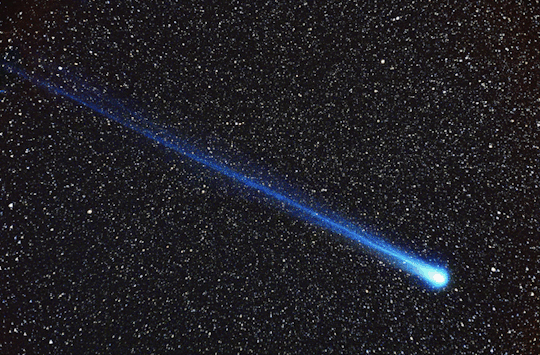
Comet Hyakutake
3K notes
·
View notes
Photo

Simulations reproduce complex fluctuations in soft X-ray signal detected by satellites Researchers from Tokyo Metropolitan University have used numerical methods to model the variations observed in soft X-ray signals detected by X-ray satellites. They analyzed data from the Suzaku telescope and compared it with modeling of solar winds interacting with the most upper parts of our atmosphere. They succeeded in capturing how the signal varied with the orbital motion of the satellite, with implications for how predictions can be made for future satellite experiments. In the 1990s, the German orbital X-ray telescope ROSAT began detecting large variations in signals in the soft X-ray part of the spectrum that lasted a day or so. These were similar to the copious flux of soft X-rays from the comet Hyakutake discovered around the same time. It was proposed that these were due to solar wind, fluxes of charged particles arriving from the sun, and how they interact with neutral ions in the upper extremities of our atmosphere, or the geocorona. More detailed observations in the 2000s confirmed the telltale spectra of these events, known as solar wind charge exchange events (SWCX), and the mechanism itself was widely accepted. However, modeling how solar wind gives rise to the measurements taken by orbital telescopes proved much more difficult. It requires successfully capturing the arrival of solar wind events, how the charged particles interact with neutral atoms, and how that affects the magnetosphere, not to mention how these phenomena combine to give rise to the variation in signal observed over time and space by the satellites. Now, a team led by Associate Professor Yuichiro Ezoe of Tokyo Metropolitan University have successfully brought these aspects together to realize a model that can successfully reproduce how the signal varies over time. The team’s focus was on data from Suzaku, an X-ray telescope satellite launched in 2005 by the Japan Aerospace Exploration Agency. In contrast to other satellites, Suzaku lies in a lower orbit, allowing it to observe the polar cusps of the magnetosphere, where solar winds are being strongly bent away. A highlight of the team’s work is not only the wide range of astrophysical events they are able to bring together, but how it may be mapped onto real data. The model showed excellent correspondence with experimental data, reproducing the signal observed up to a factor of two, an impressive feat in the field. Furthermore, they were able to reproduce the particularly strong variations in the signal when the line of sight of the satellite aligned with the polar cusps. There were some notable exceptions, like when a major geomagnetic storm was observed; nevertheless, successful reproduction of the variations holds significant promise for predicting the outcomes of the next generation of X-ray observations in space. IMAGE....Charged particles from the sun coming towards earth interact with the geocorona, a wide cloud of hydrogen atoms extending into space from the Earth. Charge is transferred to the hydrogen atoms, and soft X-rays are emitted. CREDIT Tokyo Metropolitan University
1 note
·
View note
Photo
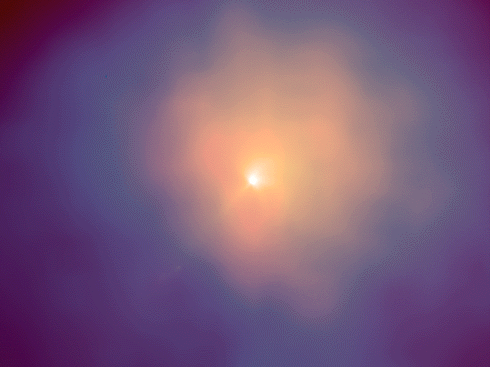
Hyakutake: Comet Atmosphere
Credits: M. Combi, SPRL, U. Mich., STScI, NASA
61 notes
·
View notes
Photo

Comet Hyakutake streaks through space on March 25, 1996, observed from the Johannes-Kepler-Observatory in Linz, Austria.
942 notes
·
View notes

